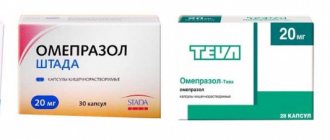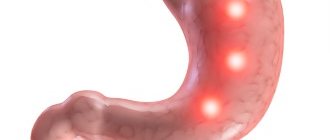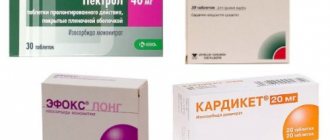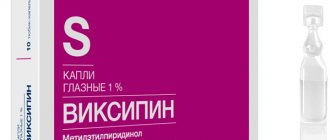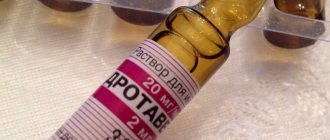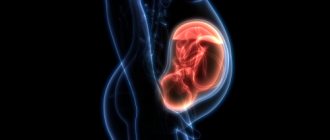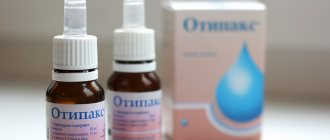Poor nutrition, frequent consumption of alcohol, and unhealthy foods lead to peptic ulcers, gastritis and other gastrointestinal pathologies, which are characterized by pain and other unpleasant sensations.
Omeprazole-Akrikhin is often used to treat them.
This drug is antiulcer and has many beneficial properties.
The product is available in hard capsules that dissolve in the stomach, as well as in powder form for preparing an injection solution. The cost of the medicine is 280 - 230 rubles.
Release form and composition
The drug is produced in the form of enteric capsules 20 mg: hard gelatin, size No. 1, with a yellowish-cream body and a dark green cap; Inside the capsules are white or almost white pellets (10 pieces each in blister packs, 1, 2 or 3 packs in a cardboard pack and instructions for use of Omeprazole-Akrikhin).
Composition per 1 capsule:
- active ingredient: omeprazole – 20 mg;
- auxiliary components of pellets: sodium lauryl sulfate, sodium hydrogen phosphate, corn starch, sucrose, lactose monohydrate, propylene glycol, cetyl alcohol, titanium dioxide, sodium hydroxide, polysorbate-80, hypromellose, mannitol, copolymer of ethyl acrylate and methacrylic acid;
- capsule body: gelatin, titanium dioxide, yellow iron oxide dye;
- Capsule cap: gelatin, titanium dioxide, black iron oxide dye, yellow iron oxide dye.
Characteristics of Omeprazole
The main active ingredient is omeprazole. Excipients: sodium lauryl sulfate, disodium hydrogen orthophosphate, calcium carbonate, mannitol, sugar, hydroxypropyl methylcellulose E5, diethyl phthalate, methacrylic acid copolymer, talc, titanium dioxide, gelatin, nipagin, glycerin, nipazole, purified water, sodium lauryl sulfate, titanium dioxide.
The medication is prescribed for the following pathologies:
- reflux disease,
- hypersecretory conditions,
- acute pancreatitis,
- peptic ulcer of the stomach and duodenum.
The drug inhibits both nighttime and daytime acid production. In addition, it has a bactericidal effect on Helicobacter pylori, increasing the susceptibility of bacteria to antibacterial agents and eradication therapy.
The drug is prescribed for oral administration. The capsule is swallowed without damaging its integrity, washed down with plenty of water.
Pharmacological properties
Pharmacodynamics
Omeprazole is a proton pump inhibitor. It slows down the activity of H+/K+-ATPase in special cells located in the wall of the stomach, thereby blocking the final stage of hydrochloric acid secretion. Omeprazole is a prodrug that is activated in an acidic environment. It reduces stimulated and basal secretion of hydrochloric acid, and this effect does not depend on the nature of the stimulus. The antisecretory effect occurs within the first hour after taking 20 mg of Omeprazole-Akrikhin (sometimes within the first two hours). The duration of inhibition of 50% of maximum secretion is 24 hours.
With a single daily dose of Omeprazole-Akrikhin, effective and rapid inhibition of night and daytime gastric secretion is ensured, which reaches a maximum after 4 days and disappears 3-4 days after the end of treatment. In persons with duodenal ulcer, taking 20 mg of Omeprazole-Akrikhin helps maintain the pH level inside the stomach at 3.0 for 17 hours. Due to a decrease in acid secretion, the plasma concentration of CgA (chromogranin A) increases.
Pharmacokinetics
Absorption of omeprazole is high. The maximum plasma concentration is achieved within 0.5–3.5 hours. The bioavailability of the drug is about 30–40%, but in patients with liver failure it increases and is almost 100%. Since omeprazole is highly lipophilic, it easily enters the parietal cells of the stomach. 90–95% of the active substance is bound to proteins (mainly albumin and acidic alpha 1-glycoprotein).
The half-life is 0.5–1 hour (in patients with liver failure it extends to 3 hours). Clearance is 500–600 ml/min.
Omeprazole undergoes hepatic metabolism (with the participation of the CYP2C19 enzyme system). As a result, pharmacologically inactive metabolites are formed (sulfonic and sulfide derivatives, hydroxyomeprazole, etc.). Omeprazole inhibits the CYP2C19 isoenzyme. About 70–80% is excreted by the kidneys, another 20–30% with bile.
In patients with chronic renal failure, drug excretion decreases in proportion to the decrease in CC (creatinine clearance).
In elderly patients, the excretion of omeprazole decreases and bioavailability increases.
Indications for use
In adults, Omeprazole-Akrikhin capsules are used for the following diseases:
- reflux esophagitis;
- peptic ulcer of the duodenum and stomach - for treatment and prevention of relapses;
- gastrinoma (Zollinger-Ellison syndrome);
- systemic mastocytosis (excessive number of mast cells in body tissues);
- stress ulcers of the gastrointestinal tract (gastrointestinal tract);
- gastropathy due to taking NSAIDs (non-steroidal anti-inflammatory drugs);
- multiple endocrine adenomatosis;
- Helicobacter pylori infection in patients with duodenal and gastric ulcers – to eradicate the bacterium, as part of complex treatment.
In childhood, Omeprazole-Akrikhin is used to treat GERD (gastroesophageal reflux disease) in children over 2 years of age and duodenal ulcer associated with the bacterium Helicobacter pylori in children over 4 years of age.
Analogues and cost
The product is a drug in the middle price category, which makes it accessible to almost everyone. The cost depends on the purchased dosage and form of the drug. For example, Omeprazole-Akrikhin 20 mg costs up to 50 rubles per package (30 pcs.), and at a dosage of 40 mg the cost will be approximately 200 rubles.
The most popular generics of Omeprazole-Akrikhin in Russia are: Gastrozol, Omezol, Omefez, Omez, Losek and Bioprazol. There are also drugs that are not used in Russia, but are registered in Europe. These are drugs such as Prilosec, Romesec, Proseptin, Lokit and Antra MAPS.
Many people wonder what the difference is between Omez and Omeprazole. These are, in fact, two similar drugs containing the active substance omeprazole. However, its quantity, and therefore its effectiveness, may vary.
Omez contains quite a lot of excipients, so it is not recommended for people with a tendency to allergic reactions. Due to the presence of sucrose, sodium lauryl sulfate and titanium dioxide, omeprazole is concentrated in the body at a lower rate, although it is eliminated from it much faster. Analogs often cost less than the original drug and, accordingly, are more common.
"Omez", however, is still recognized by experts as a fairly effective remedy for the treatment of pathologies of the gastrointestinal tract.
Contraindications
Absolute:
- deficiency of isomaltase/sucrase, lactase, fructose intolerance, rare hereditary forms of lactose intolerance, glucose-galactose malabsorption syndrome;
- children under 2 years of age and the child’s body weight less than 20 kg (for symptomatic treatment of sour belching and heartburn with GERD, as well as for the treatment of reflux esophagitis);
- children under 4 years of age or a child’s body weight less than 31 kg (for treatment of duodenal ulcers caused by the bacterium Helicobacter pylori);
- children and adolescents up to 18 years of age (for all indications, with the exception of GERD and duodenal ulcer caused by the bacterium Helicobacter pylori);
- combined use with clarithromycin (in patients with liver failure);
- simultaneous use with nelfinavir, erlotinib, St. John's wort and posaconazole;
- hypersensitivity to omeprazole or auxiliary components of the capsules.
Relative (Omeprazole-Akrikhin is used with caution):
- osteoporosis;
- the presence of alarming symptoms (repeated vomiting, including blood; significant weight loss; changes in the color and consistency of stool; difficulty swallowing);
- liver failure;
- renal failure;
- cyanocobalamin deficiency;
- simultaneous use with clopidogrel, warfarin, diazepam, saquinavir, clarithromycin, rifampicin, itraconazole, phenytoin, tacrolimus, voriconazole and cilostazol;
- pregnancy period.
In what cases is the drug contraindicated?
Despite all the effectiveness of Omeprazole-Akrikhin, which provides symptomatic relief and recovery, it is not approved for everyone. The reasons for the ban are clearly stated:
- Individual sensitivity
to the components of the drug. An allergic reaction can include a rash, hives, swelling, fever, and even anaphylactic shock. - Carrying a child
. Studies of the effect of omeprazole on pregnant women have identified the risk of complications both in the mothers themselves and in the children born to them. Treatment is prescribed only when the benefit outweighs the threat to health. - Feeding period
. Nursing mothers who have been prescribed appropriate treatment are advised to temporarily stop feeding for the same reasons as during pregnancy. - Childhood
. The drug is prohibited, despite studies and permission to use it in the treatment of children in other countries. - Kidney
and
liver failure
, especially in chronic form.
The manufacturer warns that the drug is contraindicated after the expiration date, which is 2 years.
Omeprazole-Akrikhin: instructions for use (dosage and method)
Omeprazole-Akrikhin is taken orally, usually in the morning. Capsules should be swallowed whole with water (immediately before or during meals).
Recommended doses and duration of treatment for adults:
- reflux esophagitis, exacerbation of peptic ulcer, gastropathy due to taking NSAIDs: 20 mg once a day; in case of severe reflux esophagitis, the dose is increased to 40 mg once a day; duration of therapy: esophagitis and gastric ulcer – 4–8 weeks, duodenal ulcer – 2–3 weeks (sometimes up to 4–5 weeks);
- prevention of relapse of peptic ulcer: 20 mg once a day;
- gastrinoma (Zollinger-Ellison syndrome): 60 mg once a day; if necessary, increase the dose to 80–120 mg in 2–3 doses;
- destruction of the Helicobacter pylori bacterium: triple therapy (course is 1 week) – 20 mg omeprazole + 500 mg clarithromycin + 1000 mg amoxicillin 2 times a day, or 20 mg omeprazole + 250 mg clarithromycin + 400 mg metronidazole 2 times a day, or 40 mg omeprazole once a day + 400 mg metronidazole 3 times a day + 500 mg amoxicillin 3 times a day; double therapy (course is 2 weeks) – 20–40 mg omeprazole + 750 mg amoxicillin 2 times a day, or 40 mg omeprazole 1 time a day + 500 mg clarithromycin 3 times a day, or 40 mg omeprazole 1 time a day + 750–1500 mg amoxicillin 2 times a day.
Recommended doses of Omeprazole-Akrikhin and duration of treatment for children:
- GERD in children over 2 years of age (body weight more than 20 kg): 20 mg 1 time per day; if necessary, the daily dose is increased to 40 mg; the course of treatment is from 4 to 8 weeks;
- duodenal ulcer associated with the bacterium Helicobacter pylori (in children over 4 years of age): 20 mg 2 times a day together with amoxicillin and clarithromycin (their dosage regimen is indicated in the relevant instructions for these drugs); course of treatment – 1 week.
For patients with liver failure, the maximum dose of Omeprazole-Akrikhin is 20 mg per day.
Elderly people and patients with renal failure do not require dose adjustment of omeprazole.
Price
Average price in Russia
Typically, the cost of Omeprazole-Acri does not exceed 100 rubles, so it is considered a fairly cheap drug.
Average cost in Ukraine
Omeprazole-Acri is difficult to find in Ukraine. If you wish, you can buy an analogue of this drug, i.e. Omeprazole, the average cost of which is from 30 to 40 hryvnia.
Video on the topic: how to get rid of heartburn? treatment of food ulcers, gastritis, duodenitis, hiatal hernia with soda
Side effects
During therapy with Omeprazole-Akrikhin, the following side effects from systems and organs were recorded:
- digestive system: often - vomiting, nausea, abdominal pain, flatulence, diarrhea or constipation; rarely – stomatitis, dry mouth, microscopic colitis, gastrointestinal candidiasis;
- hepatobiliary system: uncommon – increased activity of liver enzymes; rarely – jaundice, hepatitis; very rarely - encephalopathy (in patients with liver disease), liver failure;
- metabolism and nutrition: rarely – decrease in sodium level in the blood; with unknown frequency – decreased concentration of magnesium in the blood;
- respiratory system: rarely – bronchospasm;
- lymphatic system and blood: rarely – thrombocytopenia, leukopenia; very rarely - pancytopenia, neutropenia; with an unknown frequency - a decrease in the number of eosinophils;
- nervous system and psyche: often – headache; uncommon – drowsiness or insomnia, dizziness, sensitivity disorders in the form of tingling and numbness; rarely - taste disturbance, confusion, agitation, depression; very rarely – hallucinations, aggression;
- sense organs: infrequently – vertigo; rarely – taste disturbance, blurred vision;
- musculoskeletal system: uncommon – fractures of the wrist, vertebrae and hip; rarely – pain in muscles and joints; very rarely - muscle weakness;
- skin and subcutaneous fat: uncommon – itching, urticaria, dermatitis, skin rash; rarely - increased photosensitivity, pathological hair loss; very rarely - toxic epidermal necrolysis, erythema multiforme;
- immune system: rarely - hypersensitivity reactions (Quincke's edema, fever, anaphylactic shock/anaphylactic reactions);
- urinary system: rarely – tubulointerstitial nephritis;
- reproductive system and mammary gland: very rarely - enlarged mammary glands in men;
- other reactions: rarely - peripheral edema, malaise; infrequently – increased sweating.
With long-term treatment with drugs from the group of proton pump inhibitors, there have been cases of the formation of benign glandular cysts in the stomach.
special instructions
Therapy with proton pump inhibitors can mask the symptoms of malignant processes; therefore, before starting treatment, it is necessary to exclude the presence of cancerous tumors in the stomach.
An increased concentration of CgA in plasma can affect the examination results when detecting neuroendocrine neoplasms, therefore, 5 days before the examination, it is necessary to temporarily stop taking Omeprazole-Akrikhin.
With long-term use of high doses of proton pump inhibitors, there may be a moderate increase in the risk of fractures, especially in the elderly or in patients with other risk factors.
After 3 months of taking omeprazole, cases of severe hypomagnesemia were reported, which was manifested by symptoms such as dizziness, fatigue, ventricular arrhythmia, convulsions and delirium. This condition can be controlled by discontinuation of proton pump inhibitors and additional use of magnesium-containing drugs.
Like other drugs that reduce gastric acidity, Omeprazole-Akrikhin can reduce the absorption of cyanocobalamin (vitamin B12).
In people who take medications for a long time that reduce the secretion of gastric glands, glandular cysts often form, which go away on their own with further therapy. Such phenomena are associated with physiological characteristics resulting from inhibition of acid secretion.
With reduced secretion of hydrochloric acid, the growth of natural intestinal microflora increases, which may slightly increase the risk of intestinal infections caused by bacteria of the genus Campylobacter and Salmonella, and in hospitalized patients - by the bacterium Clostridium difficile.
Impact on the ability to drive vehicles and complex mechanisms
There are no data on the effect of Omeprazole-Akrikhin on the patient’s ability to drive vehicles and other mechanisms. However, side effects such as drowsiness, dizziness and blurred vision should be taken into account, and caution should be used when performing any work that requires quick reactions and high concentration.
Use during pregnancy and lactation
Based on research results, the absence of adverse effects of omeprazole on the course of pregnancy and the health of the fetus and newborn has been proven. As a result, Omeprazole-Akrikhin is approved for use during pregnancy. The drug should be used with caution.
Omeprazole passes into breast milk, but when used in therapeutic doses, its effect on the child is unlikely. Omeprazole-Akrikhin is approved for use during lactation (breastfeeding).
Drug interactions
Omeprazole may reduce or increase the absorption of drugs whose bioavailability is affected by gastric acidity (including itraconazole, ketoconazole, cyanocobalamin, erlotinib, posaconazole and iron supplements).
When used together with omeprazole, a significant decrease in the plasma concentrations of nelfinavir and atazanavir is possible; increasing plasma concentrations of ritonavir/saquinavir by up to 70%; increase in digoxin bioavailability by 10%; increased plasma concentrations of diazepam, cilostazol, warfarin, phenytoin and other drugs in the metabolism of which the CYP2C19 isoenzyme is involved.
In patients who take warfarin for a long time, a change in coagulation time is observed with concomitant administration of omeprazole 20 mg once daily, therefore, in such patients it is necessary to monitor the INR (International Normalized Ratio) and, if necessary, adjust the dose of warfarin.
Omeprazole reduces the plasma concentration of clopidogrel (this combination is not recommended); increases the concentration of tacrolimus (dosage adjustment may be required); slightly increases the level of methotrexate in the blood.
Rifampicin and St. John's wort preparations enhance the metabolism of omeprazole and reduce its content in the blood plasma.
Erythromycin and clarithromycin increase the plasma concentration of omeprazole, while metronidazole and amoxicillin do not affect it.
No interactions were noted with diclofenac, ethanol, lidocaine, estradiol, theophylline, naproxen, propranolol, quinidine, piroxicam, metoprolol, cyclosporine, antacids and caffeine.
Combination with other medications
The result of treatment is influenced by a complex of drugs, and their chemical components influence each other. What can Omeprazole-Akrikhin be taken with at the same time, and what shouldn’t it be taken with it?
Research data is shown in the table:
| Not recommended to be combined with | No interaction found with |
|
|
Omeprazole alters the effectiveness of drugs whose action is dependent on pH
. Moreover, it can both reduce the therapeutic result and enhance it.
During its use, the drug has earned positive reviews.
Another advantage is low cost
facilities. The difference in price in pharmacies is small - a package with 30 capsules of Omeprazole-Akrikhin can be purchased for less than 100 rubles. A good reason to prefer this particular medicine, given its time-proven effectiveness.
Reviews of Omeprazole-Akrikhin
According to reviews, Omeprazole-Akrikhin is well tolerated by patients and is a fairly effective remedy for gastrointestinal problems associated with high acidity. The drug treats the cause of heartburn and eliminates other unpleasant symptoms of gastropathy. Its action develops quite quickly. According to some indications, capsules can be used in children as young as 2 years old. The drug is inexpensive and accessible.
Among the most frequently mentioned disadvantages of the drug are the existing contraindications and possible side effects.
Dosage
The daily dosage of the drug should not exceed 60 mg. The following phenomena will signal an overdose:
- Confusion.
- Tachycardia.
- Severe migraines.
- Labored breathing.
- Drowsiness.
- Heavy sweating.
- Dry mouth and nose.
- Heat in the body.
It is strictly forbidden to continue taking it if you have the above symptoms. It is necessary to immediately stop the drug and consult a specialist. The doctor will prescribe therapy aimed at relieving symptoms and reduce the dosage of Omeprazole-Akrikhin or completely stop taking it in favor of another drug.
